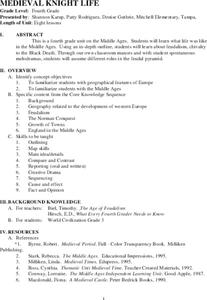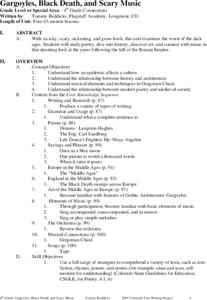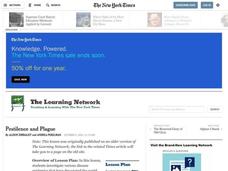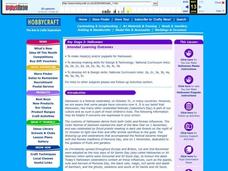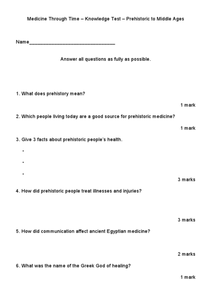Mr. Roughton
History Mystery: The Black Death
Was the medieval Black Death the same disease as the modern bubonic plague? Your class members become the top investigators in the case, examining a variety of exhibits (i.e. disease descriptions, sample historical letter, map, etc.) in...
Curated OER
The Black Death and HIV/AIDS: Which is the Worse Plague?
Exploring the similarities and differences between the Black Death and HIV/AIDS, students write persuasive essays answering which is the "worse plague." This cross-curricular activity between Language Arts and Social Studies addresses...
Curated OER
The Path of the Black Death
Students analyze maps, firsthand accounts, and archival documents to trace the path and aftermath of the Black Death. Connections between the plague and changes adopted by the ruling class are explored in this lesson.
Curated OER
The Black Death: 1347 - 1351
Grim and gruesome, the Black Death literally infects history with its social and political ramification. Your class will be positively agog over the details of the Plague, from its causes to its symptoms, and eventually to its grisly end...
Curated OER
The Black Death Epidemic of the 14th Century
Students examine the effects of the Black Death in the 14th century. Using the internet, they research the disease and its symptoms along with how communities were affected. In pairs, they read an article and answer comprehension...
Curated OER
The Black Death
In this health worksheet, middle schoolers find the words associated with the "Black Death" and the answers are found at the bottom of the page.
Curated OER
The Fall of Rome and the Beginning of the Middle Ages
A major turning point in world history is the focus of this presentation. Rome has fallen, and with its descent comes the Dark Ages. With pictures, maps, and important information about the Middle Ages, this slideshow would be a great...
Curated OER
British History
A very quick overview of nearly a millennium of British history, these slides present broad topics supported by photographs and small pieces of information. The end of the presentation prompts viewers to create a timeline based on the...
Curated OER
Medieval Knight Life
Students research the Middle Ages. In this Middle Ages lesson, students complete lessons about feudalism, life on a manor, chivalry and knighthood, an activity about the Battle of Hastings, the growth of Middle Age towns, the trial by...
Glynn County School System
Lives and Deaths of Stars
Star light, star bright ... just how long can you wish on that star? Well, it depends on its mass. The presentation explains the life cycle of stars based on their sizes. Scholars learn about the life expectancy of a star based on the...
Curated OER
Gargoyles, Black Death, and Scary Music
Students research the Dark Ages using books, the Internet, and other media. In this Dark Ages lesson plan, students study poetry, music, art, and the architecture of the Dark Ages.
Smithsonian Institution
Western Indian Wars
Why do many Native Americans live on reservations? An interactive resource teaches about how reservations came to be and the tragic history behind Native Americans moving from their lands. Teenagers read passages, view images, and click...
4HimKids
Biography Worksheet
Learn more about a famous person in history and record this information on a biography format worksheet. After conducting research on a person of interest, biographers record information about their...
Curated OER
The War of the Roses Study Guide
In this "War of the Roses" study guide worksheet, students discover details about 10 of the significant figures during this period of British history.
Curated OER
Role Playing the Plague
Students investigate the impact of the plague. In this European history lesson, students listen to their instructors present information regarding the black death and then write letters regarding the plague from the perspective of 14th...
DocsTeach
The Impact of Bloody Sunday in Selma
Who is to blame when a peaceful protest turns deadly? Scholars research the impact of the civil rights march in Selma, better known as Bloody Sunday. The activity uses files from the FBI's investigation to help academics understand the...
Facing History and Ourselves
Emmett Till: Choosing to Remember
Mamie Till, the mother of Emmett Till and civil rights activist, believed that her son's murder was the last straw before public outrage over racial injustice spilled over into the Civil Rights Movement of the 20th century. A history...
New Class Museum
Lesson: Emory Douglas: Decoding Images and Vocabulary Activity
To better understand the work of Black Panther logo artist Emory Douglas, learners define literary devices. They define a series of words such as metaphor, simile, and assonance, then place an example of that device found in Emory...
Curated OER
Black Alabamians in World War I
Eleventh graders describe the racial climate of Alabama, then discuss some of the war-related concerns of black and white Alabamians.
Curated OER
Casting Doubt: "Color-blind" and Nontraditional Casting Decisions
In his article about color-blind casting entitled, "Willy Loman Is Lost, Still Looking for Stimulus Plan and Some Dignity," Charles Isherwood quotes August Wilson as saying, "To mount an all-black production of a 'Death of a...
Curated OER
Pestilence and Plague
Students investigate various disease epidemics that have devastated the world population at different points in history and examine the diseases' effects on the countries they impacted.
Curated OER
Viruses: Tiny But Deadly
In this viruses worksheet, learners read given information about the effect of viruses on people throughout history. Students create a bar graph comparing the viruses and answer seven questions based on the information they have learned.
Curated OER
Halloween
Discover the origins and traditions of Halloween with a crafty lesson plan! Second graders create bats, monsters, witches, and ghosts with masks and puppets. Next, they share their work with their classmates in a fun...
Curated OER
Medicine Through Time
In this medicine in history worksheet, students read through the questions about the history of medicine. Students give short answers to the 18 questions.








